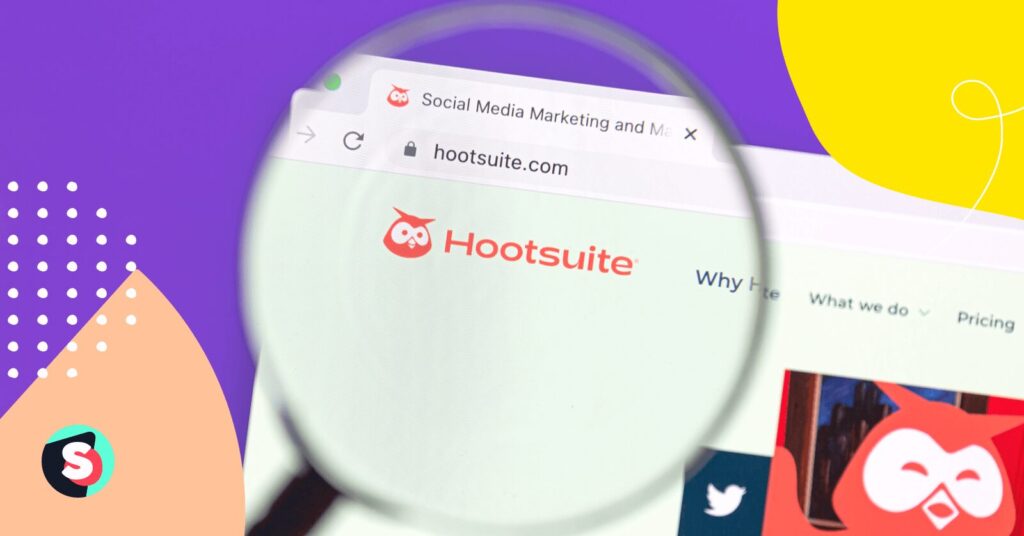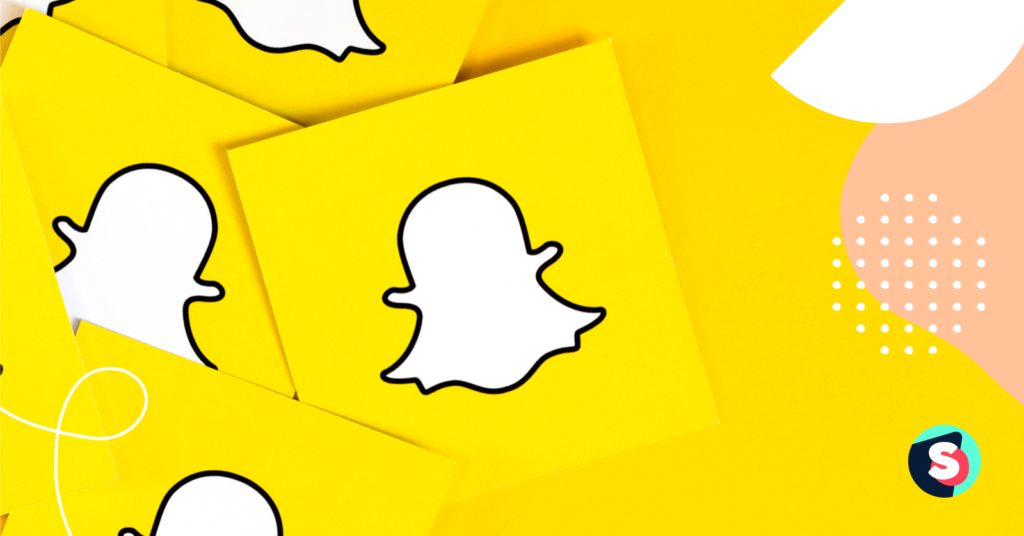Summarize this article via
Hootsuite hits freelancers and small teams the hardest in terms of price, even as it helps them manage multiple social accounts like a big brand.
If that sounds a bit too familiar, you’re not the only one.
When you scroll through G2 or Capterra, you’ll see the same pattern over and over. Hootsuite has a good feature set, but it is expensive and paywalled.
On Capterra, one reviewer calls it “too expensive for your startups,” describing it as a solid scheduler with a price that’s “prohibitive for a young startup with minimal budget.” And when you look at Hootsuite’s own pricing—$249/month for the most commonly suggested team package and $99/month for the entry plan—it becomes even harder to justify when some alternatives (like Sociality.io) offer more flexibility and depth at that same $99 level.
So you end up with a powerful tool that’s expensive and paywalled.
- TL;DR: Hootsuite pricing hurts 💔 Here are better options
- Where does Hootsuite fall short in 2026 & Why consider a Hootsuite alternative?
- How to choose the best Hootsuite alternative for your team
- The top 8 alternatives to Hootsuite: Which competitor will be your dream tool?
- Wrapping up
And to be real: social media in 2026 isn’t a side channel. It’s where 5.4 billion people connect, across nearly seven platforms per user, spending up to 2.5 hours a day scrolling, engaging, and consuming content.
Brands are pouring $276 billion into ads, and 71% of marketers now see clear ROI, with high-investment brands experiencing 32% faster revenue growth. In this landscape, modern management tools are not just helpful—they’re essential.
Many users now face challenges with Hootsuite’s per-seat pricing, limited depth for advanced needs like competitor analysis or listening, and a dated UX that makes collaboration clunky.
If you’re looking for modern, efficient, and scalable alternatives to Hootsuite—ones that actually match your workflow without the cost creep—this guide is for you.
Ready? Let the social media tools war begin.
TL;DR: Hootsuite pricing hurts 💔 Here are better options
If Hootsuite’s $99/mo (1 user) and ~$249/mo (3 users) plans feel steep—especially with per-seat pricing—these alternatives can fit better. Sociality.io is the most “all-in-one” pick for growing teams and agencies, with unlimited users from $199/mo and strong reporting. Sendible is best for agency-style approvals and client-ready reports. Vista Social is great if you want modern automation and AI workflows. If your main pain is analytics, Sociality.io with deep analytics or Iconosquare can be your analytics-first option. On a tight budget, SocialPilot and Metricool offer solid scheduling and reporting for less. For simple creator scheduling, go to Buffer or Later.
Where does Hootsuite fall short in 2026 & Why consider a Hootsuite alternative?
If Hootsuite is so established, why are people searching for Hootsuite alternatives instead of just sticking with it?
To be fair, Hootsuite still scores well overall: around 4.3/5 on G2 and 4.4/5 on Capterra, with many users praising its breadth and scheduling features.
But if you scroll through the “cons” tabs, the same themes keep popping up: pricing, per-seat licensing, a cluttered interface, glitches, and important features locked behind higher-end plans.

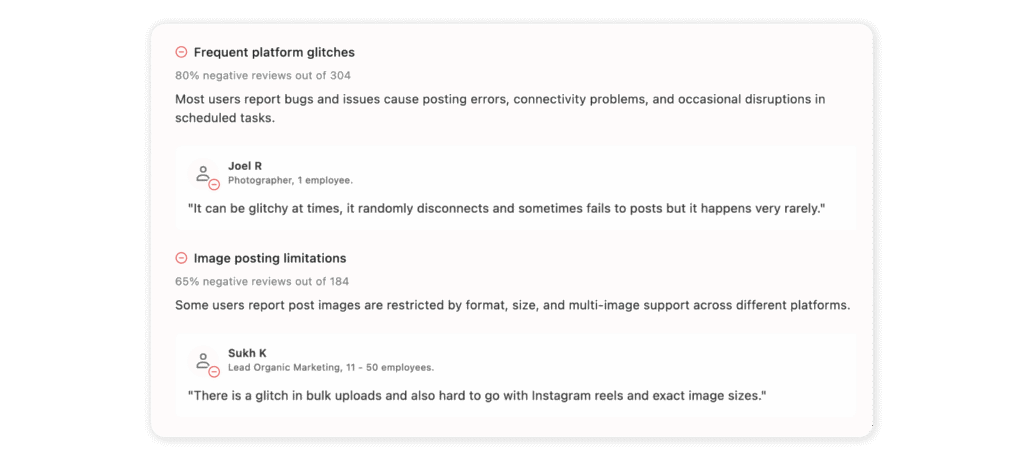
A few reviewers even say they eventually left purely because the cost and complexity stopped making sense for their team size.
Let’s see the main reasons people start looking for alternatives to Hootsuite in 2026.
1.High pricing and per-seat licensing
Hootsuite no longer has a permanent free plan since 2023, and the entry tier starts at about $99 per month for one user and 10 social accounts.
Pricing also scales with user seats. Team plans start at roughly $249 per month for three users, while Enterprise requires at least five users and 50 social accounts on custom pricing.
That model hits growing teams hard.
As soon as you add a few users, the bill jumps, and reviewers regularly describe Hootsuite as “expensive” or poor value for smaller businesses.
One Capterra user calls it “absolutely unaffordable for small businesses and startups,” and says they were paying the equivalent of more than ten dollars per post before they quit.

And the most critical part of these price-related cons is the per-user model.

Sociality.io takes a different route; its Business plan is priced at $199, and it doesn’t have per-user fees.
So while Hootsuite can make sense for bigger organizations with deeper pockets, creators, small teams, and many agencies find themselves looking for cheaper Hootsuite alternatives with flatter, more predictable pricing.
2.Steep learning curve and cluttered UX
On paper, Hootsuite’s interface looks powerful. In practice, a lot of users say it simply feels like too much.
One G2 reviewer from a company with 51-1000 employees puts it plainly:
“The interface is little busy—there’s a learning curve before all the streams and tabs feel second-nature.”
Another long-time user on Capterra is even more blunt:
“My overall experience with Hootsuite was below average. It left much to be desired in terms of user experience.”

You see the same theme again and again in reviews: “A bit clunky but ultimately helpful,” “the interface can feel quite clunky at times,” and “glitches frequently, issues with scheduled posts was frequent.” Hootsuite does a lot, but you often have to fight the UI to get to the value—especially if you don’t have much time, so you just want to plan content, hit publish, and move on.
That’s where many Hootsuite alternatives lean in: cleaner calendars, less “stream” overload, and workflows that feel closer to how teams actually plan content today. Sociality.io, for example, focuses on a simple, modern UI that most users can pick up with little more than basic Instagram knowledge, which makes a real difference if you don’t have time (or patience) for a steep learning curve.
3.Limited analytics depth on lower tiers
Hootsuite absolutely offers analytics—but the good stuff usually lives higher up the pricing ladder.
Analyses from CRM.org highlight that you get relatively basic analytics on Professional, while more advanced reporting, ROI metrics, and paid + organic dashboards are reserved for Business/Enterprise or paid add-ons.
You can feel that same theme in user feedback.
A non-profit social media manager on G2 says, “while the standard analytics are good for a quick overview, pulling the really deep, customized data we need… can sometimes be less flexible than I’d like without paying for more advanced add-ons.”
Another G2 reviewer puts it more broadly: “Limited features on lower plan and the pricing.” And G2’s own roll-up notes that “users find the limited features on Hootsuite’s lower plan restrain their social media management capabilities.”
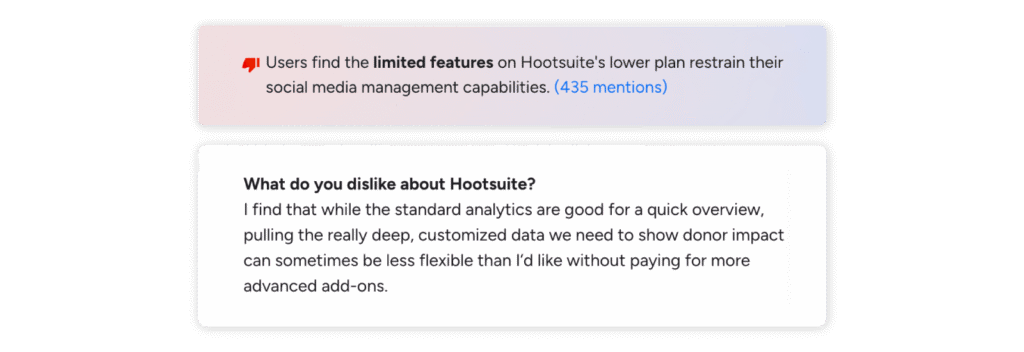
By contrast, tools like Sociality.io include multi-channel dashboards, competitor benchmarking, and exportable PPT/PDF/Excel reports on non-enterprise plans.
4.Collaboration and key features gated by higher plans
Collaboration is another pain point—especially for agencies and multi-brand teams.
Hootsuite’s Professional plan doesn’t include real team collaboration. To unlock multi-user workflows, approvals, or more advanced roles and permissions, you have to move up to Team or Enterprise, where both the user count and the monthly bill jump sharply.
Capterra reviews echo this pattern.
One digital solutions lead sums it up neatly: “The interface can feel cluttered at times, and key features like analytics and team collaboration are locked behind higher-tier plans.” For smaller teams or growing agencies, that “pay more to actually collaborate” model adds up fast.
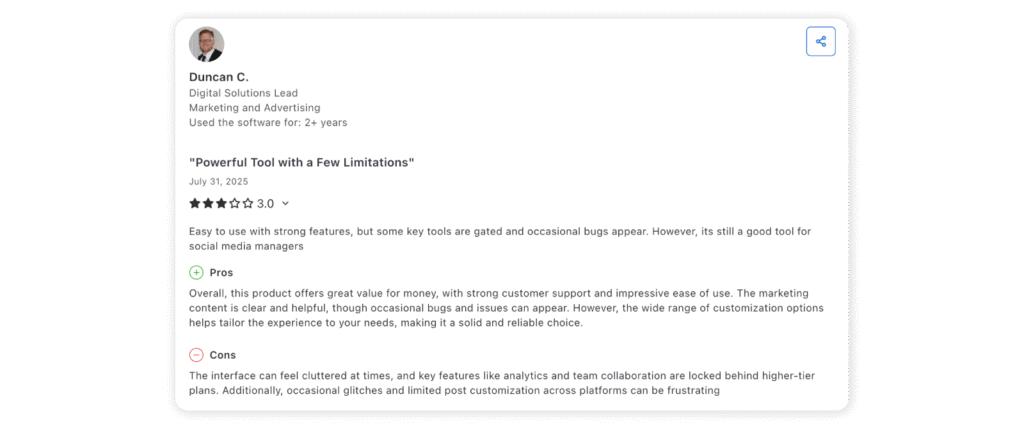
From a user’s perspective, it can feel like you’re constantly bumping into invisible walls: you try to add a collaborator, send a client-ready report, or manage approvals properly—and the answer is “upgrade again.”
That’s why so many teams, especially agencies, actively look for Hootsuite alternatives that offer:
- Approvals and internal notes on mid-tier plans
- Fewer hidden limits on exports, scheduled posts, or workspaces
With Sociality’s Business plan ($199/month), you get unlimited users, so enterprises can onboard full teams—and agencies can add teammates and clients—without extra user fees. You can also set workspace/client-based roles and permissions, ensuring each client only accesses their own accounts and approved actions.
5.Support, price changes, and long-term trust
With Hootsuite, teams don’t just feel the high starting price—they also worry about sudden hikes. 🤯
Some long-time customers report steep increases and confusing plan changes, which makes budgeting tricky for smaller teams. Pair that with limited-hours support and mixed experiences around billing issues, and long-term trust starts to crack.

Sociality.io goes in the other direction: pricing has stayed stable for years; if you care about predictability and trust as you grow, that difference matters a lot.
How to choose the best Hootsuite alternative for your team
Not every Hootsuite alternative solves the same problems. Some are pure schedulers, some are analytics-first, and some are built for agencies from day one.
Let’s zoom in on how to actually compare platforms like Hootsuite.
Choose the best Hootsuite alternative for your needs
The “best” Hootsuite alternative isn’t universal—it’s the one that fits your workflows, budget, and team structure without making you fight the tool every day.
What makes a good Hootsuite alternative?
A strong alternative to Hootsuite should give you:
- A cleaner, more modern UI instead of a cluttered, tab-heavy dashboard
- Fair, transparent pricing (with options that don’t punish small teams or light users)
- Analytics and reporting that go beyond basic reach and engagement
- Collaboration that works for both in-house teams and agencies
- Fast product development, especially around short-form video and AI
- Support that feels accessible and human, not just a slow ticket queue
How I evaluated the alternatives to Hootsuite 🔍
Here’s the short version of the criteria behind this list:
- UX and workflows – How many steps from idea to scheduled post? Can you understand the calendar at a glance?
- Feature depth – Publishing, analytics, listening, collaboration: does it actually help you do the work, or just tick boxes?
- Pricing and value – How the real cost compares to Hootsuite for different team sizes (per-seat vs flat, limits, add-ons).
- Security and reliability – Permissions, basic data handling, and whether it’s stable enough for daily use.
- Support quality – How quickly and clearly you can get help: chat, onboarding, docs.
- Real-world feedback – Patterns in G2 and Capterra reviews, plus Reddit threads from teams that have already switched.
With that in mind, let’s review each Hootsuite alternative.
The top 8 alternatives to Hootsuite: Which competitor will be your dream tool?
Before diving into the deep dives, here’s a bird’s-eye comparison.
Quick comparison of Hootsuite alternatives:
| Tool | Best for | Biggest strength | Biggest trade-off | Starting price |
|---|---|---|---|---|
| Sociality.io | Growing teams & agencies | All-in-one suite with strong reporting | Listening is an add-on | $99/mo |
| Sendible | Agencies | White-label & client reports | Advanced features cost more | $29/mo |
| Vista Social | AI-focused teams | Automation & unified inbox | Newer platform | $79/mo |
| Iconosquare | Analytics-heavy brands | Deep analytics & benchmarks | Less full-suite coverage | €33/mo |
| SocialPilot | Budget teams | Many profiles for low cost | Basic UX | $30/mo |
| Buffer | Creators | Simple scheduling | Limited analytics | Free + paid |
| Metricool | Data-driven marketers | Strong analytics | Features gated | Low–mid tiers |
| Later | Visual creators | Visual planning | Limited analytics | Free + paid |
*Starting prices are approximate and may vary by billing cycle and region. Always check current pricing.
Hootsuite alternatives for agencies and multi-client teams
If you’re juggling five brands, three markets, and a dozen stakeholders, you don’t just need “a scheduler”—you need a calm command center. For agencies and larger in-house teams, the real priorities are collaboration, client-ready reporting, and pricing that doesn’t explode every time you add a new login.
1. Sociality.io
Sociality.io is a full-stack social media management platform that brings publishing, engagement, analytics, competitor benchmarking, and listening into a single workspace.
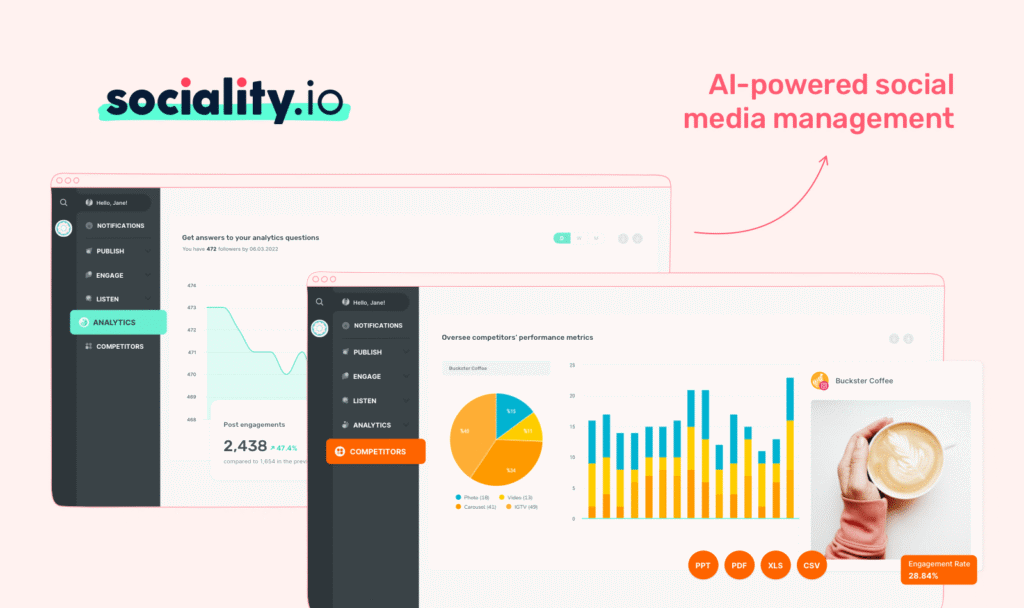
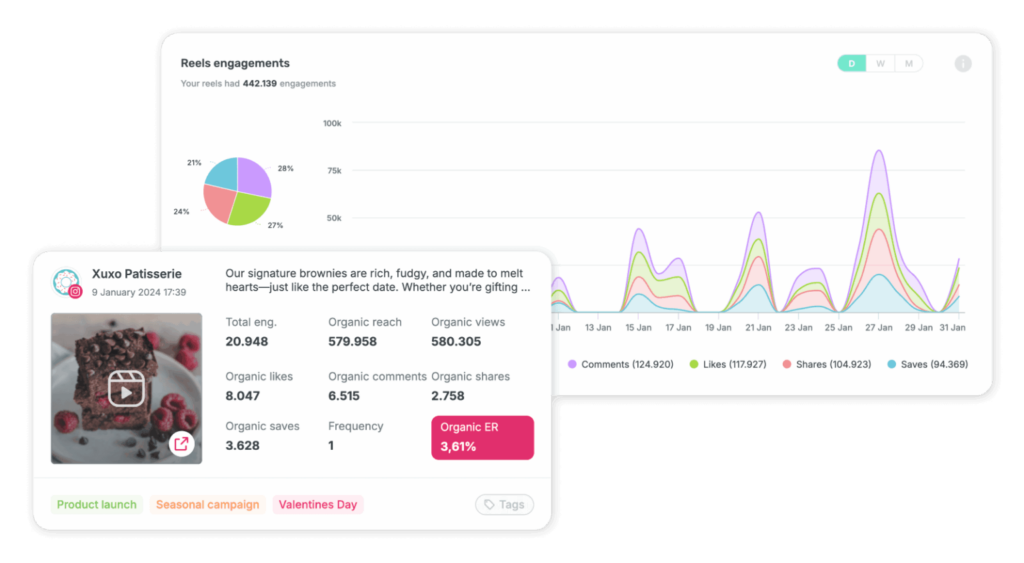
Unlike Hootsuite, it’s built for modern teams and agencies—the ones juggling multiple brands, several platforms, and constant reporting deadlines.
Hootsuite vs Sociality.io
| Hootsuite | Sociality.io | |
| Pricing | From ~$99/month, per user | From $99/month. Unlimited users on Business & Enterprise plans from $199/month. |
| Best for | Established teams that “just” need scheduling | Growing teams & agencies managing multiple brands |
| Analytics | Solid basics, deeper reports on higher tiers | Multi-channel & competitor analytics, easy exports |
| Collaboration | Real team features on higher plans only | Built-in roles, approvals, multi-brand workspaces |
| UX & support | Can feel clunky and pricey as you scale | Clean UI, fast support, pricing stable for 3+ years |
👉 On G2, Sociality.io sits at 4.8/5, and on Capterra at 4.6/5, with consistently high marks for ease of use, analytics, and collaboration.
Best for ❤️
In-house marketing teams of enterprise-level businesses and agencies managing multiple brands that want a true all-in-one Hootsuite alternative, not just a scheduler.
Ideal team size/maturity
Small-but-growing teams, mid-sized or large-sized companies, and agencies. It’s more than a solo freelancer usually needs, but once you have multiple stakeholders, it starts to shine.
Key features and standout strengths 💪
- Unified suite: publishing calendar, social inbox, analytics, competitor analysis, and listening in one dashboard.
- Unified inbox to engage with followers across supported platforms in real time.
- Support for major networks: Facebook, Instagram, LinkedIn, TikTok, YouTube, X, and more.
- AI roadmap for 2026: conversational analytics—chat with your analytics using natural language.
AI in every module:
- Analyze listening data and auto-tag themes
- Reply, rephrase, and rewrite with AI in the inbox
- Summarize collected data and competitor reports
- Turn raw listening or competitor data into concise insights
In practice, that means less manual tagging and reporting—and more time actually acting on your data.
“We manage 100+ social media pages for 30+ clients, and the customer support team at Sociality.io is simply great. They helped us onboard new team members, scale our processes, and always listened to our needs.” — G2 reviewer, Business Development Manager
“I can say the best social media reporting app I have used so far.” — Capterra reviewer, Content Group Head
“As with all software, sometimes small bugs occur. However, the amazing and ready-to-help customer support team helps us in time.” — G2 reviewer
So yes, there are occasional small bugs — but users consistently say support jumps on them fast, which is a very different story from Hootsuite reviews that mention glitches, failed posts, and slow or limited help.
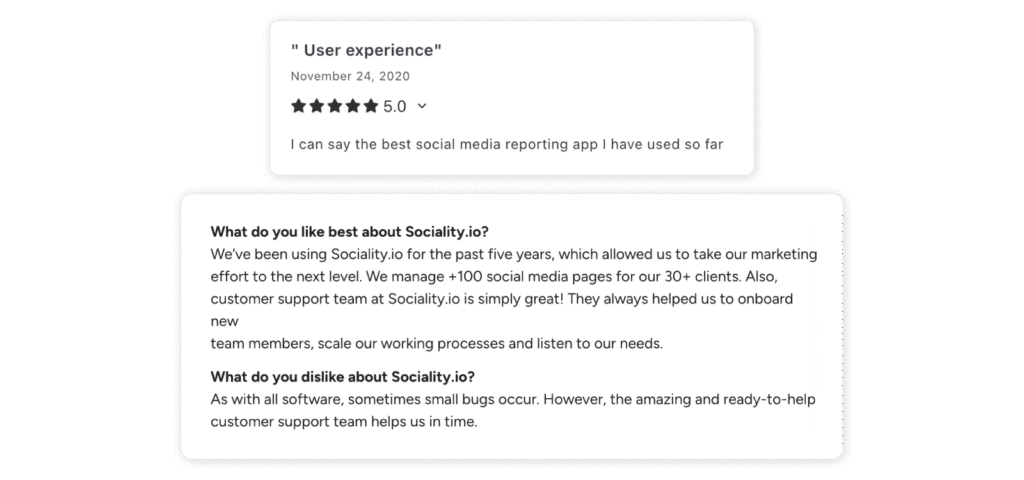
Analytics and reporting depth
Sociality.io is built for teams that live inside reports:
- Cross-network dashboards with post-level insights and time-series trends in one place.
- Post-level intelligence per channel: reactions, impressions, content-type performance, plus paid vs. organic impact (especially on Meta).
- Campaign/tag-based reporting (e.g., launches, promos, seasonal campaigns) to see which initiatives actually move the needle.
- Viewer countries, traffic sources, online-followers heatmaps for best times to post, engagement breakdowns, hashtag performance, CTR, watch time, followers gained per post, and non-follower reach — all brought together in a single, structured view.
- Branded exports to PPT, PDF, and Excel, with scheduled reports sent automatically to stakeholders.
- Agencies report higher engagement and dramatically less time spent on reporting after switching.
- For anyone feeling boxed in by Hootsuite’s lower-tier analytics, it’s a genuine step up in depth and usability.
Collaboration and workflows
Sociality.io is very agency-friendly:
- Multi-brand workspaces with roles, approvals, and internal notes
- Assignment workflows in the inbox and publish modules
- Team performance reports to track response times and workload
Mapping a client workflow onto this is much easier than trying to bend a rigid enterprise UI into shape.
Pricing and value 💵
This is where it really diverges from Hootsuite:
- Pro: $99/month, 1 user, 10 pages/social media accounts
- Business: $199/month, unlimited users, 15 pages/social media accounts — with flexible per-page add-ons, keep your budget flexible.
- Enterprise: custom pricing, still unlimited users, plus advanced security and data retention
From Business upwards, there’s no per-seat pricing — which is huge for agencies and multi-brand teams.
And with their unlimited-user pricing, they’ve stolen some Redditors’ hearts.

Page limits/social media accounts are flexible, so you don’t have to jump to Enterprise just because you add a few more profiles.
Sociality.io’s pricing hasn’t changed in the last 3 years, and they don’t plan to raise it in the near future, so budgeting feels more predictable than with tools that keep bumping prices. Plans with unlimited users start at $199/month, and there’s also a $99/month Pro plan with advanced features.
UX, support, and reliability
This is also a common reason people switch from Hootsuite:
- The UI is clean and simple, with a modern calendar view and clear navigation.
- Customers report saving hours on reporting—a case study mentions going from “a whole day” of reporting to 15 minutes.
- Support responds in under 30 minutes on average, with live chat, email, and 1:1 onboarding available.
If you’ve felt lost in legacy dashboards, this alone is a big quality-of-life upgrade. 😌
Limitations/trade-offs
- Social listening is a separate add-on, so if you’re listening-heavy, factor that in.
- For solo creators with very basic scheduling needs, it may be more platform than necessary.
Choose this if…
You manage multiple brands, care about analytics, and want powerful engagement, social inbox, and moderation capabilities—all in one AI-powered Hootsuite alternative that doesn’t punish you for adding users.
Skip this if…
You only need a very simple, mostly free Hootsuite alternative for a couple of profiles.
Last but not least, the results speak for themselves—here’s what customers are saying about Sociality.io:
“With the help of Sociality.io, we increased our engagement rates by 2.5 times within a 6-month period.” — Mehmet Kecili, VMLY&R
“Before using Sociality.io, I would spend a whole day preparing a detailed report. Now with Sociality.io, it takes me 15 minutes tops.” — Sena Arısoy, Engage Istanbul
Why is Sociality.io a better choice than Hootsuite?
Sociality.io is often a better choice than Hootsuite because you get an all-in-one suite (publishing, inbox, analytics, competitor tracking, listening), deeper reporting, unlimited users from the Business plan, a cleaner UI, and faster, more accessible support—without the per-seat pricing and heavy feature gating that frustrate a lot of Hootsuite users.
2. Sendible
Sendible is designed specifically with agencies in mind: multi-client management, strong reporting, and white-label options.

Hootsuite vs Sendible
| Hootsuite | Sendible | |
| Pricing | From ≈$99/month per user; costs rise fast as you add seats | From ≈$29/month; agency-friendly tiers based on profiles, not headcount |
| Best for | Established teams that mainly need scheduling and centralized management | Agencies & small teams managing multiple clients and brands |
| Analytics | Solid basics; deeper/custom reports on higher tiers or as paid add-ons | Client-ready, branded reports and templates built for recurring agency reporting |
| Collaboration | Full team workflows and approvals on higher, per-seat plans | Agency-first roles, approvals, profile groups, and a unified Priority Inbox on key plans |
| UX & support | Powerful but often described as busy/cluttered; mixed support | Often praised as “easy to use” and “grows with your business,” with responsive support |
👉 Sendible scores 4.5/5 on G2 and 4.6/5 on Capterra with many reviewers highlighting how well it fits agencies and small businesses managing multiple clients.
Best for ❤️
Agencies managing many client profiles who want polished, client-ready reporting and structured workflows.
Ideal team size/maturity
Growing agencies and in-house teams with multiple stakeholders, regular approvals, and recurring client reporting.
Key features and standout strengths 💪
- Built for multi-client management with profile groups and clear separation between brands.
- White-label reports and client portals on higher tiers so agencies can put their own branding on deliverables.
- Direct integration with major social platforms plus extras like Canva and Pexels to speed up content production.
From G2, an enterprise social media manager sums it up:
“It’s easy to manage multiple social media accounts on Sendible… We use the approvals function too, and it all works well for us.”
On Capterra, a small-business user notes:
“Sendible is flexible, easy to use, and easy to understand. It can also grow with the growth of your business.”
These are exactly the areas where many agencies feel Hootsuite is heavier and less tailored.
Analytics and reporting depth
- Ready-made channel reports for Facebook, Instagram, LinkedIn, X, and more.
- A Report Hub with in-depth, presentation-ready reports designed to impress clients.
- Strong fit for agencies that need to send regular, branded PDFs without rebuilding dashboards every month.
Compared to Hootsuite’s deeper analytics being pushed to higher tiers and add-ons, Sendible leans harder into “agency-ready” reporting out of the box.
Collaboration and workflows

- Approvals, roles, and team access are designed around agency workflows (assign posts, delegate conversations, review flows).
- A unified Priority Inbox that pulls key conversations from multiple profiles into one stream.
- Clear separation between client accounts so teams don’t step on each other’s toes.
Hootsuite can do collaboration too, but it often requires jumping to higher, per-seat plans. Sendible’s structure feels much more agency-first from the start.
Pricing and value 💵
- Public pricing starts around $29/month (Creator), then scales with plans like Traction as you add more profiles and features.
- Designed so agencies can manage many profiles from one hub without immediately jumping into enterprise-style, per-seat pricing like Hootsuite.
Limitations/trade-offs
Real-world reviews do flag some downsides:
On G2, a VP of Marketing notes recurring reliability issues:
“We’ve experienced recurring issues with LinkedIn integration. Posts don’t always publish as scheduled, and at times the connection between Sendible and LinkedIn needs to be refreshed or reauthorized unexpectedly.”

So, big picture:
- Still overkill if you’re a solo freelancer with just a couple of profiles.
- Some advanced features (like full white-label branding) live on higher tiers.
Choose this if…
- You’re an agency replacing Hootsuite and care most about client-ready, branded reports, approvals, and multi-client structure.
- You want a tool your team and clients can grow into without rebuilding your entire stack in a year.
Skip this if…
- You just need a cheap, simple scheduler for one brand.
- You don’t manage clients and don’t really need white-label or agency-style approvals.
Why is Sendible a better choice than Hootsuite?
For agencies and small teams managing multiple clients, Sendible is often a better choice than Hootsuite because it’s cheaper per profile, built around agency-first workflows (approvals, profile groups, client-ready reports), and generally easier to use without fighting a cluttered, per-seat enterprise UI.
3. Vista Social
Vista Social is a modern, AI-focused Hootsuite competitor with a clean UI, unified inbox, and smart automation built for today’s formats (short-form video, DMs, advocacy, etc.).
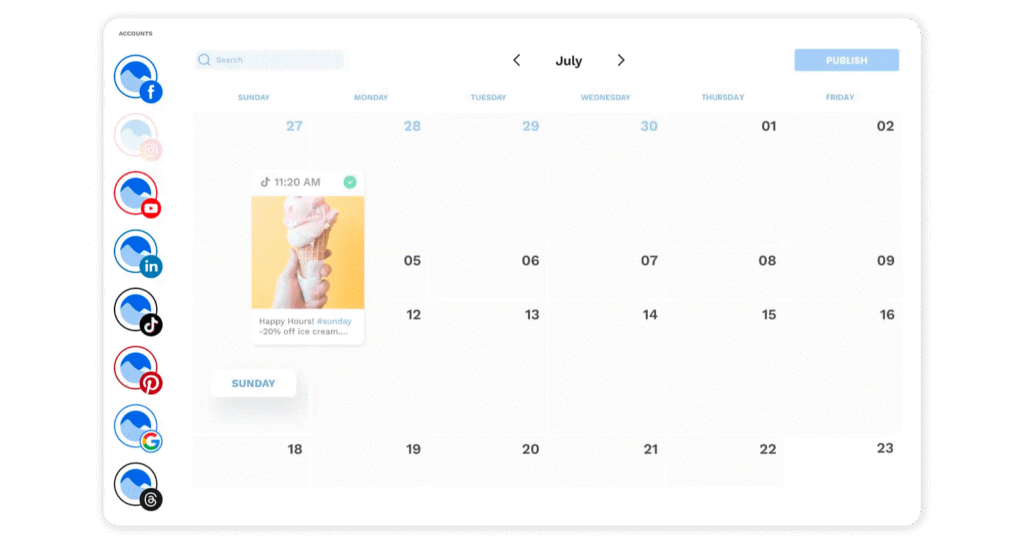
Hootsuite vs Vista Social
| Hootsuite | Vista Social | |
| Pricing | From ≈$99/month per user; costs rise quickly as you add seats | From ≈$79/month; strong price-to-feature ratio, tiers scale mainly by profiles/features |
| Best for | Established teams that mostly need scheduling + basic centralisation | Brands & agencies wanting modern automation, AI, and unified management across channels |
| Analytics | Solid basics; deeper/custom reports on higher tiers or as add-ons | Multi-channel performance reports; enough depth for most small–mid teams, but less custom |
| Collaboration | Team workflows on higher plans; more “classic” enterprise feel | Unified inbox, review links, tasks, and advocacy tools designed for reactive, fast workflows |
| UX & support | Powerful but often described as busy or “clunky” in reviews | Frequently praised for time-saving workflows and unified view; some mention glitches/setup friction |
👉 Vista Social holds a 4.8 rating on G2 and a 4.9 rating on Capterra, with reviewers frequently noting its “value for money” and unified management across channels.
Best for ❤️
Brands, agencies, and social teams that want a fresh, automation-heavy platform (AI, queues, DM flows, advocacy) instead of a retrofitted legacy dashboard.
Ideal team size/maturity
Small to mid-size teams and agencies that are comfortable with newer SaaS products and want more automation than Hootsuite offers at a similar or lower price.
Key features and standout strengths 💪
- All-in-one publishing, analytics, and engagement with a unified inbox
- Strong automation: queues, DM workflows, best-times-to-post, evergreen scheduling
- AI writing and listening tools tuned for modern content workflows
Backed up by real user feedback:
On G2, a mid-market marketer says:
“I love how Vista Social allows me to manage multiple social media accounts across various channels efficiently… the ability to show optimal times for scheduling posts and convert them into evergreen settings is very effective for my content strategy… I’m highly impressed with the listening feature and sentiment analysis, which I find to be incredibly powerful and typically not affordable for smaller businesses.” – Sonja C., Marketing & Advertising
On Capterra, a social media specialist highlights the “all-in-one” feel:
“The app combines a multitude of tools into a single platform, making it effortless to handle every aspect of social media management, from scheduling posts to monitoring metrics.” – Amanda T., Social Media Specialist
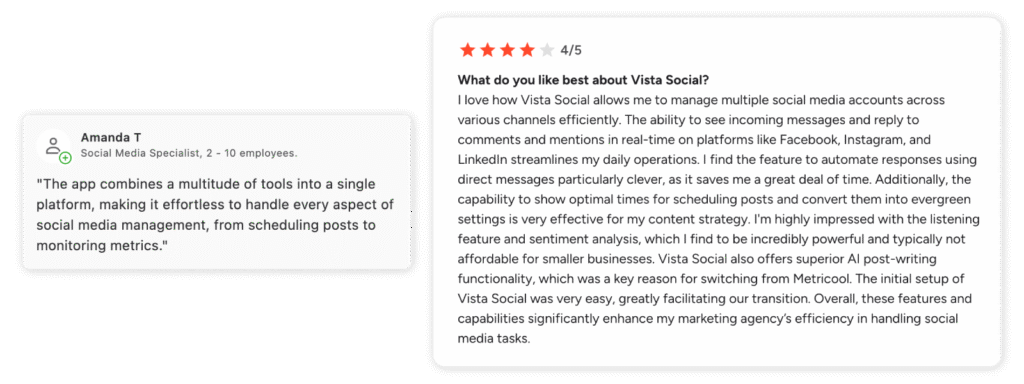
Analytics and reporting depth
- Multi-channel reporting for major platforms (e.g., Meta, LinkedIn, YouTube, TikTok)
- Performance dashboards that are “good enough” for most small–mid-size teams
- Listening and sentiment features that smaller businesses often wouldn’t get at this price point
However, some users want more granular, flexible reporting:

A G2 reviewer notes:
“The reports… lack customization options… breaking down those engagements… requires me to manually add up the numbers in the ‘post performance’ report. To make comparisons easier, I maintain a separate Excel sheet to create charts.” – Verified User in Research
Collaboration and workflows
- Unified inbox that “works better than most tools” for handling comments/messages without leaving the platform (per G2 feedback)
- Ability to send posts for review to contributors without them needing to log in
- Tasks and internal notes to organize work per account
Users explicitly call out that Vista Social reduces tool-switching and manual work:
On Capterra, one reviewer says the platform “streamlines tasks and eliminates the need to switch between multiple websites… ultimately saving me a significant amount of time.”
This is exactly where Hootsuite can feel heavier: more tabs, more clicks, and less automation out of the box.
Pricing and value 💵
Public pricing starts around $79/month (Professional), with higher plans adding more profiles and features rather than immediately pushing you into enterprise, per-seat pricing.
For teams that feel Hootsuite’s $99+ per-user plans are overkill, Vista Social often looks like a slightly more affordable way to get automation, listening, and AI.
Limitations/trade-offs
Vista Social isn’t perfect, and the cons show up clearly in reviews:
A mid-market G2 user calls out that:
“The tool also isn’t the most user-friendly… I’ve lost count of how many times I’ve had to consult the FAQ just to remember how to send a post for review,” and notes that reports use rounded numbers, forcing manual totals in Excel.” – Verified User in Research
So while Vista Social feels lighter and more affordable than Hootsuite, you’re trading some enterprise polish and ultra-stable governance for a newer ecosystem that’s still evolving.
Choose this if…
- You want a modern, AI-forward Hootsuite alternative with a unified inbox and automation that actually saves time.
- You care about value-for-money and don’t want to pay Hootsuite-level pricing just to get decent listening and DM workflows.
Skip this if…
- You need extremely customizable analytics and reporting (e.g., detailed segment cuts, very specific engagement comparisons) without doing any manual Excel work.
- You’re a large, risk-averse enterprise that prioritizes long-standing vendors, heavy governance, and ultra-stable, legacy-style workflows over newer UX and automation.
Why is Vista Social a better choice than Hootsuite?
Vista Social can be a better choice than Hootsuite if you want more automation and AI (DM flows, best-time suggestions, listening, advocacy) at a noticeably lower, non–per-seat price, with a cleaner, more modern workflow for managing multiple channels.
4. Iconosquare
Iconosquare is an analytics-first platform, historically known for deep Instagram insights and now expanded across more networks.
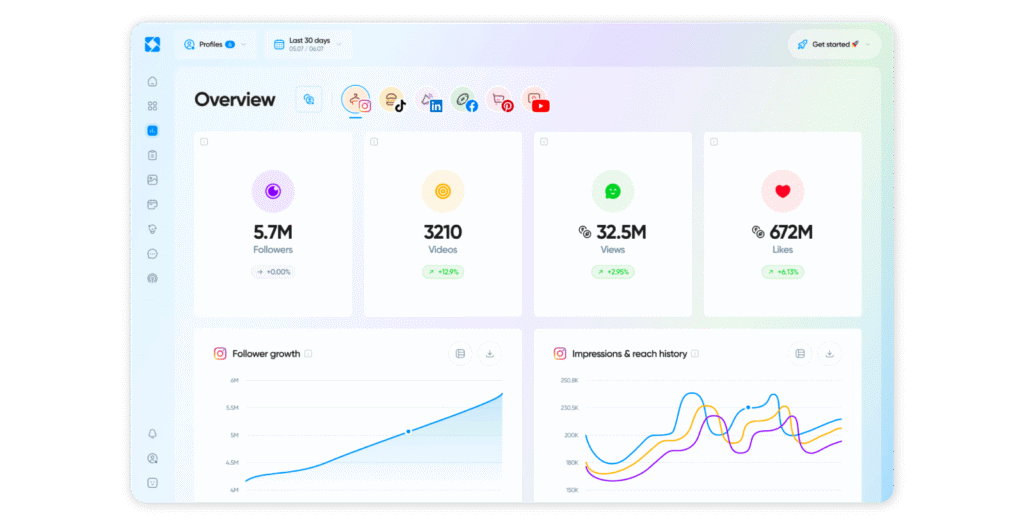
Hootsuite vs Iconosquare
| Hootsuite | Iconosquare | |
| Pricing | From ≈$99/month per user | From ≈€39/month, no per-seat pricing |
| Best for | Teams that mainly need scheduling and centralized account management | Brands/agencies that already have a scheduler and want much deeper analytics |
| Analytics | Solid basics; advanced & custom reports on higher tiers/add-ons | Analytics-first: detailed dashboards, competitor tracking, automated reports as core features |
| Collaboration | Stronger team workflows on higher, per-seat plans | Light collaboration (shared dashboards, approvals), but analytics is the star |
| UX & support | Powerful but often described as busy or “clunky” in reviews | Frequently praised as intuitive and visual, support is generally helpful but not perfect in all regions |
👉Iconosquare scores 4.5/5 on G2 and 4.4/5 on Capterra, with many reviewers highlighting its intuitive dashboard and reporting focus.
Best for ❤️
Brands and agencies where deep analytics and benchmarking are the main reasons for leaving Hootsuite, and who are happy to keep scheduling in another tool.
Ideal team size/maturity
Data-focused teams and agencies (small to mid-market) that report regularly to stakeholders or clients and want more than Hootsuite’s basic reach/engagement views.
Key features and standout strengths 💪
- Advanced, visual dashboards and trend analysis across Instagram, Facebook, LinkedIn, TikTok, YouTube, and more.
- Detailed competitor benchmarking to see how your accounts stack up.
- Strong reporting engine with automated PDF/CSV reports.
- Feed preview and post-validation flows that make client approvals easier.
From G2, one social media user puts it simply:
“Iconosquare is super efficient and saves me a lot of time on social media strategy. The automatic posts are a life-saver! I love the feed view, and I find the share link very useful.”
On Capterra, a global CDO notes:
“From automated monthly performance reports to real-time engagement insights, Iconosquare helps us stay on top of our social media impact and make data-driven decisions that align with our global growth objectives.”
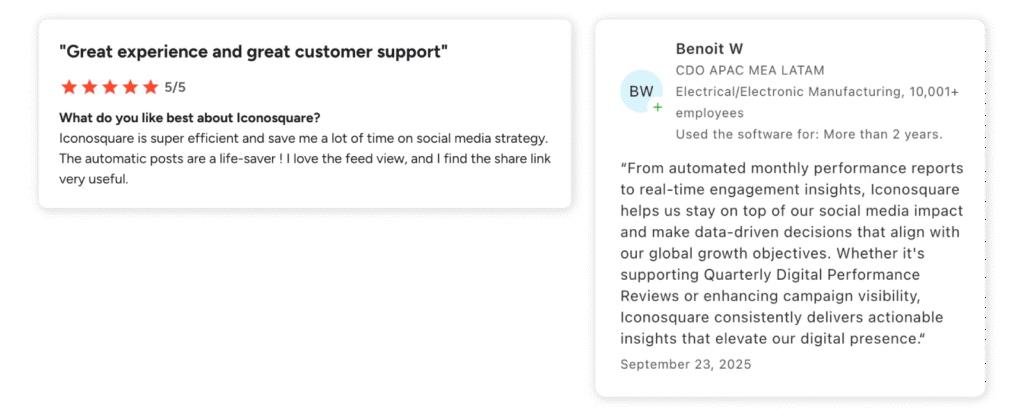
Compared to Hootsuite, where deeper analytics often sit behind Business/Enterprise tiers, Iconosquare gives you that depth as its core promise.
Analytics and reporting depth
- In-depth metrics on engagement, follower growth, reach, and content performance across multiple profiles.
- Competitor tracking and benchmarking to identify what actually works in your space.
- Automated, branded reports on a schedule—ideal for monthly client or stakeholder decks.
If your main frustration with Hootsuite is “I can’t get the data I need without upgrading again,” Iconosquare is one of the more focused ways to solve that.
Collaboration and workflows
- Centralized analytics for multiple accounts with shared access for your team.
- Feed previews and content validation that make it easier to get client sign-off.
Pricing and value 💵
- Good value if analytics and reporting are your primary needs and you’re happy to keep publishing elsewhere.
- Less compelling if you just want basic dashboards bundled into a broader management tool.
Limitations/trade-offs
To stay honest—and grounded in real reviews:
One G2 reviewer says:
“Support is not very responsive. Email support responds once daily at 2–4 AM my time… what should be a 5-minute conversation takes 5 days.” Jamie O., Digital Director (Small Business)
A Capterra user points out platform limits that aren’t entirely Iconosquare’s fault:
“We can’t add personal LinkedIn pages or platforms like X limits the amount of data we would like to get access to.” — Covadonga S., Communications Advisor (Public Policy)
So while Iconosquare is strong on analytics, it isn’t perfect on integrations or support responsiveness for everyone—and it’s not trying to replace a full social suite.

Choose this if…
- Analytics and reporting are your main reasons for leaving Hootsuite.
- You already have publishing and engagement covered and want a specialised analytics layer on top.
Skip this if…
- You want a simple all-rounder that does scheduling, inbox, listening, and analytics in one place.
- You’re a very small brand that mainly needs a scheduler; Iconosquare will feel like overkill compared to more affordable, all-purpose tools.
Why is Iconosquare a better choice than Hootsuite?
Iconosquare is a better choice than Hootsuite for teams that already use another scheduler and simply need clearer, more reliable analytics than Hootsuite’s lower-tier reporting—without paying for enterprise upgrades.
5. SocialPilot
SocialPilot is a budget-friendly social media management tool often recommended to SMBs and smaller agencies that find Hootsuite too expensive.
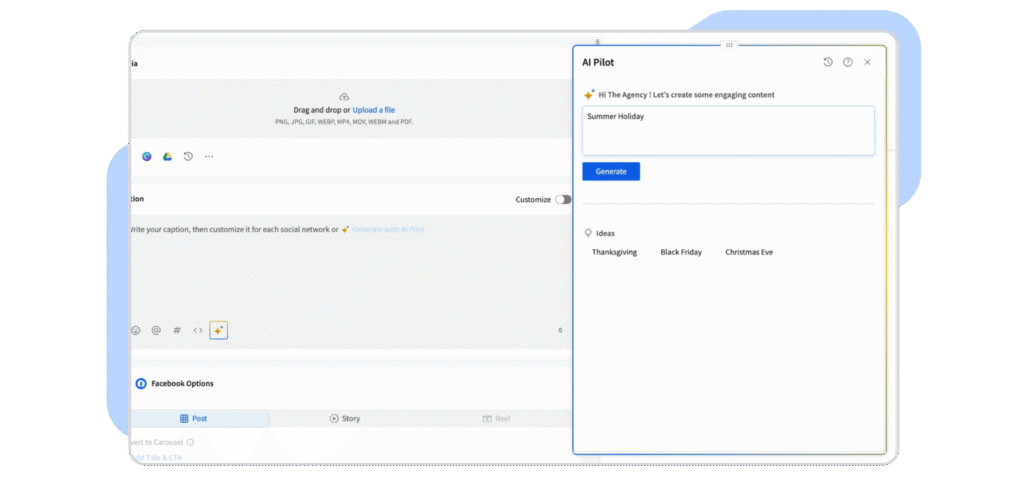
Hootsuite vs SocialPilot
| Hootsuite | SocialPilot | |
| Pricing | From ≈$99/month per user; costs rise as you add seats | From ≈$30/month; plans priced by profiles, free account for one brand |
| Best for | Established teams that mainly need scheduling + streams | Small agencies & SMBs managing lots of profiles on a tight budget |
| Analytics | Solid basics; deeper reports on higher tiers/add-ons | “Great analytics” that are good enough for most SMB monthly reports |
| Collaboration | Strong, but full workflows on higher, per-seat plans | Multi-user access and client workflows; lighter than big agency suites |
| UX & support | Powerful but often called busy/cluttered; mixed support | Frequently praised as “easy to use” and “excellent value” by small teams |
👉SocialPilot scores 4.5/5 on G2 and 4.4/5 on Capterra, with many reviewers highlighting value for money and ease of use for multi-account management.
Best for ❤️
Small agencies and SMBs that need to manage many profiles efficiently but can’t justify Hootsuite’s per-seat pricing.
Ideal team size/maturity
Solo marketers, small teams, and lean agencies handling multiple brands or locations, where cost per profile really matters more than heavyweight enterprise features.
Key features and standout strengths 💪
Built to manage, schedule, and analyze posts across many profiles from a single dashboard.
“Centralizes management of our social pages including Facebook, TikTok, Instagram, and X into one place… scheduling posts in bulk is easy.” — G2 reviewer, Digital Marketer
Strong for value-focused teams: bulk scheduling, flexible queues, repeat posts, and a simple calendar that helps you build a strategic plan instead of posting ad hoc.
“It’s excellent value, provides great analytics, bulk scheduling, flexible schedules, [and] high quality post appearance.” — Capterra reviewer, Marketing Manager
+AI-assisted content creation to speed up writing social posts without needing extra tools.
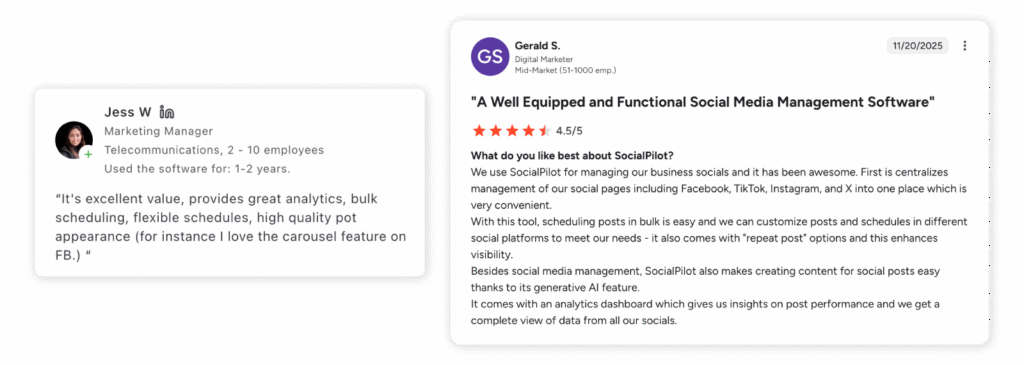
Analytics and reporting depth
- Cross-network analytics that cover the essentials for most SMB and agency monthly reporting (reach, engagement, top posts, page growth).
- Enough depth to optimize posting times and content mix, but not positioned as a specialist analytics suite.
Compared to Hootsuite, SocialPilot’s analytics are simpler but bundled at a lower price point—often “good enough” when you just need clear, regular reports rather than enterprise-level dashboards.
Collaboration and workflows
- Multi-user access and basic client workflows so teams can share one hub for multiple brands.
- Designed so one person can manage many profiles, or a small team can divide accounts without tripping over each other.
Hootsuite can go further on complex workflows, but SocialPilot gives smaller teams most of what they need without forcing them up expensive tiers.
Pricing and value 💵
- Public plans start around the $30/month mark and scale primarily with the number of social profiles, not per-user seat costs.
- Often recommended as one of the cheapest Hootsuite alternatives for agencies and SMBs that manage a lot of accounts.
One G2 reviewer managing multiple platforms for themselves and a client says SocialPilot is “the easiest and most efficient way” they’ve found to schedule across many networks—and they’ve never even needed to contact support, which tells you something about day-to-day stability.
Limitations/trade-offs
- Some platform-specific features (like Instagram tagging or collabs) sit on higher plans, which a G2 user calls out as frustrating when they’re already paying for publishing.
- A few Capterra reviewers mention that advanced analytics usage and overall stability can sometimes feel limited compared to higher-priced tools.
- It doesn’t try to compete with all-in-one suites like on deep analytics, competitor tracking, or listening.
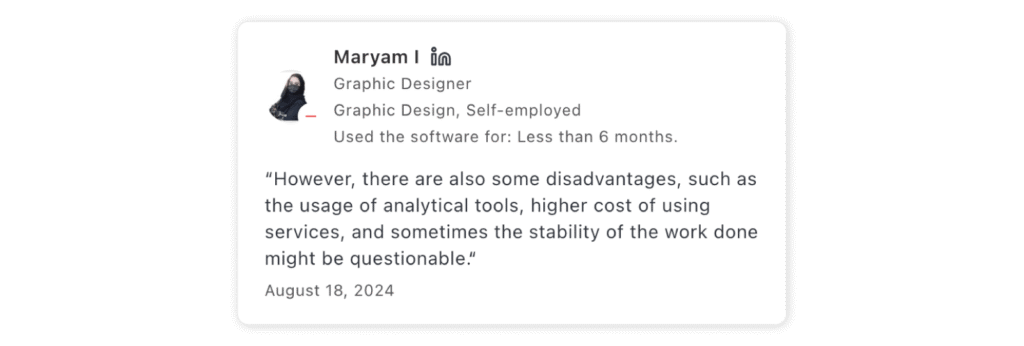
Choose this if…
- Budget is a major concern, and you need to manage many profiles efficiently.
- You want something lighter and cheaper than Hootsuite, but more capable than free native schedulers.
Skip this if…
- You need very advanced analytics, competitor benchmarking, or social listening in the same tool.
- You’re a larger agency that needs full white-label portals and complex approval chains (in which case, Sendible or an all-in-one like Sociality.io will likely fit better).
Why is SocialPilot a better choice than Hootsuite?
SocialPilot is a better choice than Hootsuite for budget-constrained teams because it lets you manage many profiles with generous limits and solid core analytics at a much lower overall cost without per-seat pricing.
Hootsuite alternatives for freelancers and small teams
Freelancers and lean teams usually care most about simplicity, clean workflows, and low cost (or free). These tools fit better when you don’t have big approval chains or complex org charts.
6. Buffer
Buffer is a lightweight, creator-friendly scheduler known for its clean UI and low-friction workflows. It’s one of the simplest Hootsuite alternatives for small teams that don’t need advanced analytics or deep collaboration.
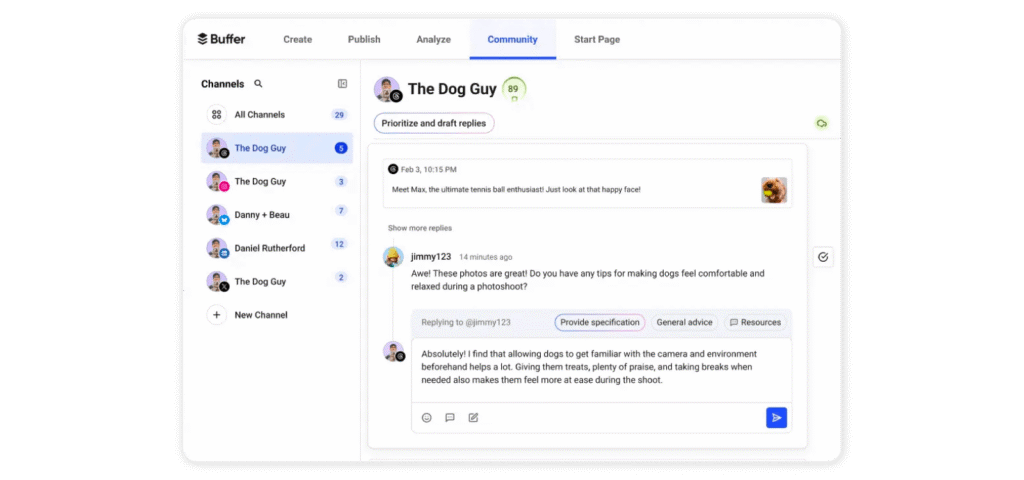
Hootsuite vs Buffer
| Hootsuite | Buffer | |
| Pricing | From ≈$99/month per user | Free plan available; paid plans scale per channel, not per user |
| Best for | Established teams needing scheduling + centralized management | Freelancers, creators, and small teams wanting simple scheduling |
| Analytics | Basic on lower tiers; upgrades needed for depth | Basic performance insights; not built for deep analytics or competitor comparison |
| Collaboration | Real team workflows on higher plans | Simple shared access and roles on paid plans |
| UX & support | Often described as cluttered, mixed support | Praised for clean, intuitive UI; supportive team, but some users report post issues |
👉 Buffer scores 4.3/5 on G2 and 4.3/5 on Capterra, with users consistently highlighting ease of use and time-saving workflows.
Best for ❤️
Freelancers, creators, and small teams who want clean scheduling and basic analytics without the bulk of a larger suite.
Ideal team size/maturity
Solo users and small teams are starting to formalize their social strategy.
Key features and standout strengths 💪
- Very intuitive interface and simple drag-and-drop calendar
- Core publishing and basic engagement tools
- Basic analytics across major platforms
- A usable free plan for low-volume posting
Real reviewers reinforce Buffer’s simplicity:
Buffer application is user-friendly, easy to use, and affordable… managing all our social media accounts in one place.” — G2 reviewer
“It efficiently accomplishes tasks, saving you time.” — Capterra reviewer
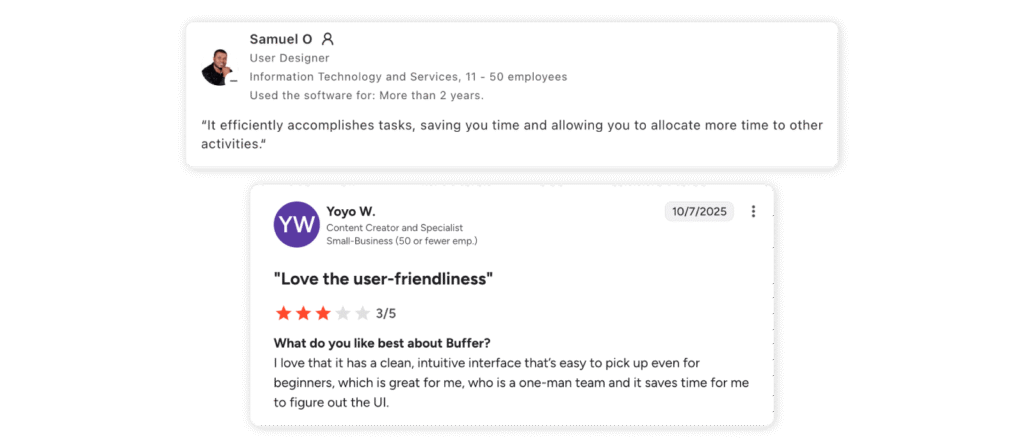
These strengths make Buffer appealing to users who find Hootsuite too heavy or too expensive for simple workflows.
Analytics and reporting depth
Analytics cover essentials like post performance and engagement trends—good enough for smaller brands, but not built for deep insights, competitor analysis, or enterprise reporting.
Collaboration and workflows
Collaboration is minimal but functional: shared access, basic roles, and simple approvals on paid plans. It works for very small teams, but not for multi-brand agencies.
Compared to Hootsuite’s higher-tier collaboration limits, Buffer’s simplicity is refreshing—but far less powerful than an all-in-one suite like Sociality.io.
Pricing and value 💵
- Free plan for limited channels
- Paid plans are billed per channel, which can become expensive as profiles grow
This is where Buffer diverges sharply from Hootsuite: cheaper upfront, but scaling can become awkward if you manage many brands.
Limitations/trade-offs
Grounded only in real user reviews:
- Frequent account disconnections — 145 Capterra reviews mention this
- Issues with image posting — 93 reviewers mention publishing problems
- Unreliable post notifications
- Limited analytics depth
A Capterra reviewer, a Lead of Digital Marketing using the tool for 2 years, shares:
“Some issues with accounts unlinking and having to go through to the integrated app and refresh the link every now and again.” – Sukh K.

Despite being simple and reliable for many, these issues show up more often for users managing multiple platforms or higher content volumes.
Choose this if…
You want a simple, affordable Hootsuite alternative, especially for one brand or a few profiles.
Skip this if…
You need strong analytics, listening, and deeper collaboration—or you plan to scale to multiple clients or brands.
Why is Buffer a better choice than Hootsuite?
Because freelancers and small teams who mainly need straightforward scheduling and basic analytics, Buffer’s clean, super-simple UI and lower, channel-based pricing make it feel much lighter and less overwhelming than Hootsuite’s heavier, more expensive, enterprise-leaning setup.
7. Metricool
Metricool is a budget-friendly, data-focused platform that blends scheduling with strong performance reporting—including web and ads data that many lower-cost tools don’t offer.
Hootsuite vs Metricool
| Hootsuite | Metricool | |
| Pricing | Higher-cost starting from $99, per-seat pricing | Budget-friendly tiers from $22 + free plan for one brand |
| Best for | Larger teams needing broad-suite management | Data-focused small teams, freelancers, SMBs |
| Analytics | Solid basics; deeper reports on higher plans | Social + ads + web analytics with strong visuals |
| Collaboration | Full collaboration on upper tiers | Basic–moderate collaboration |
| UX & support | Can feel heavy and dated | Simple UI; quick support, frequent updates |
👉 Metricool scores 4.4/5 on G2 and 4.5/5 on Capterra, with many reviewers highlighting its value for money and analytics strength at lower price points.
Best for ❤️
Marketers who prioritize performance data and integrated reporting—without paying enterprise prices.
Ideal team size/maturity
Freelancers, small teams, and SMBs who value analytics more than complex team collaboration features.
Key features and standout strengths 💪
- Scheduling, analytics, ads, and web performance in one dashboard
- Wide platform and ad-account coverage
- AI-assisted recommendations and content planning
- Reliable Chrome extension (mentioned by multiple reviewers)
Real users reinforce its strengths:
“It has a lot of functionality, it’s very reliable… and the Chrome extension is something I really need.” — G2 reviewer
“It’s the cheapest social media tool, and I don’t miss anything on it.” — Capterra reviewer
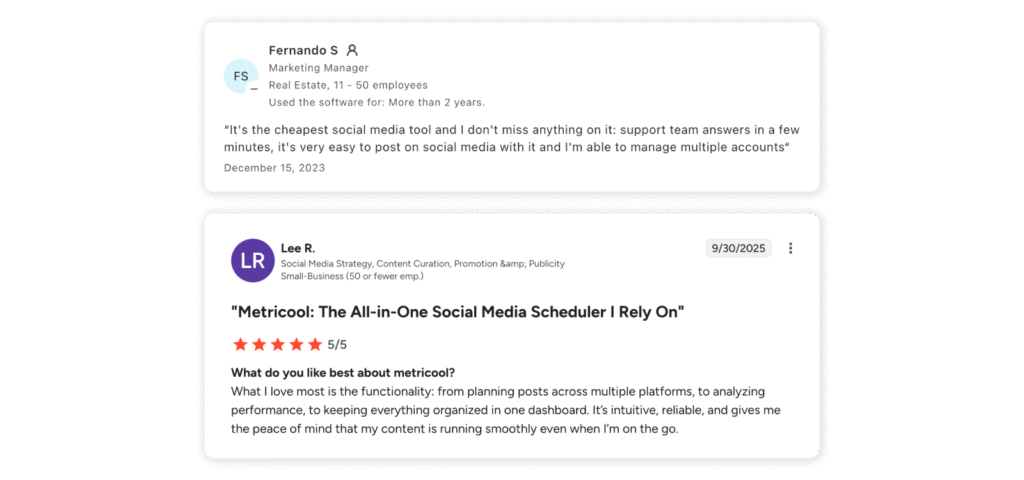
Analytics and reporting depth
Metricool offers strong analytics for its price point:
- Detailed performance dashboards
- Best-time-to-post insights
- Campaign analytics
- Social + ads + website data combined
Collaboration and workflows
- Basic collaboration tools fit small teams
- Fine for shared access, but not agency-grade
- Not suitable for white-label reporting or multi-client workflows
Pricing and value 💵
- Highly competitive pricing across tiers
- A genuinely useful free plan (one nonprofit reviewer: “We all use one login to maintain free use.”)
- Costs start from $22, lower when compared to Hootsuite’s per-seat model
Limitations/trade-offs
- LinkedIn is not included on the free plan
- Some analytics areas (Stories, Reels) need improvement
- Interface can feel dense for simple scheduling
- Advanced reporting features sit on higher tiers
- No dedicated keyword section to compare and track search volumes, as one G2 reviewer points out: “It would be good to have a section for keywords to compare and track search volumes.”

Choose this if…
You’re data-driven, on a budget, and want one tool for analytics plus scheduling.
Skip this if…
You’re a large agency that needs deep collaboration, approvals, or white-labeling.
Why is Metricool a better choice than Hootsuite?
If you care about affordability and stronger analytics for a small team, yes — Metricool is often a better fit. But if you need richer collaboration and all-in-one depth, you’ll quickly outgrow it.
8. Later
Later is a visual-first social media planner popular with creators, influencers, and brands working heavily with Instagram, TikTok, and short-form video.
Hootsuite vs Later
| Hootsuite | Later | |
| Pricing | Higher cost starting from $99, per-seat | Creator-friendly pricing starting from $25; free plan available |
| Best for | Larger teams managing many channels | Creators & small visual brands |
| Analytics | Solid basics; deeper insights on higher tiers | Simple channel insights; not advanced |
| Collaboration | Full workflows on high tiers | Light collaboration for small teams |
| UX & support | Often described as busy/cluttered | Clean, visual, beginner-friendly; some reliability issues |
👉 Later holds 4.4/5 on G2 and 4.6/5 on Capterra, with reviewers frequently praising its ease of use and visual planning tools.
Best for ❤️
Creators and visual brands who prioritize grid planning, media organization, link-in-bio, and Instagram/TikTok workflows.
Ideal team size/maturity
Solo creators to small brand teams focused on visuals rather than deep analytics or multi-brand operations.
Key features and standout strengths 💪
- Visual calendar and media library with drag-and-drop planning
- Strong Instagram & TikTok support (Reels, feed previews, hashtags)
- Link-in-bio and influencer collaboration features
- Fast setup and beginner-friendly UX
Real reviewers reinforce these strengths:
“I find Later incredibly easy to use… uploading multiple pictures and organizing posts is smooth, and auto-resizing saves time.” — G2 reviewer
“I love the calendar layout and how I can drag and drop to reschedule posts.” — Capterra reviewer
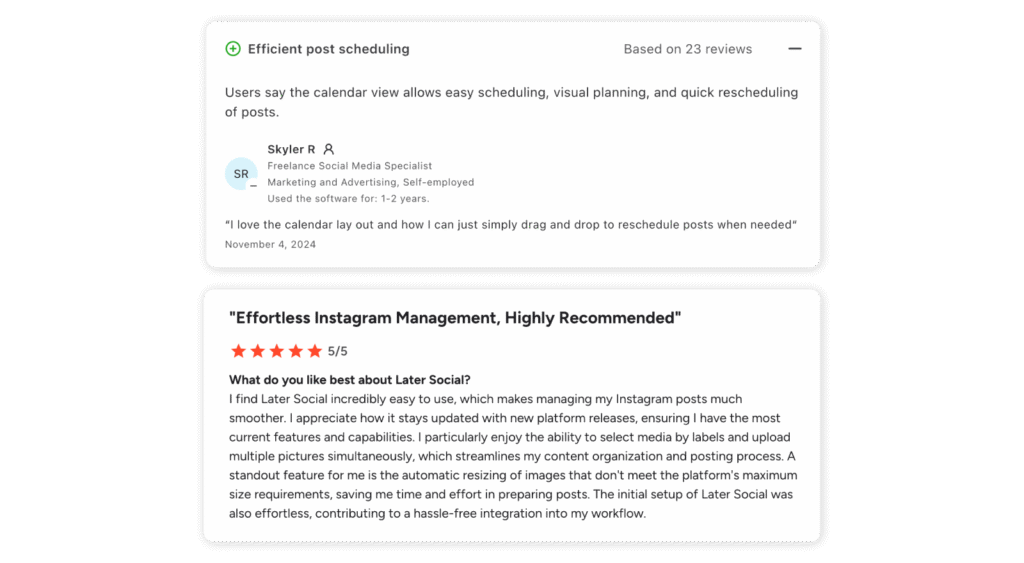
Analytics and reporting depth
Later offers simple, creator-friendly analytics:
- Basic performance trends
- Best-time-to-post indicators
- Engagement summaries
Collaboration and workflows
- Light collaboration: shared calendars and basic approval flows
- Works well for small teams
- Not suited for agencies or complex multi-brand environments
Pricing and value 💵
- Free plan available
- Paid tiers are priced reasonably for creators, starting from $25
- A practical alternative to Hootsuite for visual-centric scheduling
Limitations/trade-offs
- Occasional bugs and account disconnections
- Instagram Stories scheduling is still limited
- Posting failures reported by some users
- Paywalled features
A reviewer highlights reliability gaps:
“Sometimes it can’t save videos or reels due to the length of them or I will receive another random error message that doesn’t actually tell me why it failed.” — Capterra reviewer

Choose Later if…
You focus on Instagram/TikTok content, want a highly visual planner, and only need simple analytics—not enterprise features.
Skip Later if…
You’re an agency or multi-brand team needing deeper analytics, listening, or advanced collaboration.
Why is Later a better choice than Hootsuite?
Later is a better choice than Hootsuite if you’re a creator or small visual brand, because its clean, drag-and-drop calendar, grid preview, and Instagram/TikTok-centric workflows make planning and publishing visual content much simpler and less overwhelming than Hootsuite’s heavier, tab-packed interface.
Free Hootsuite alternatives
If your social media needs are light, a free alternative to Hootsuite might be enough to get started. Just keep in mind: free tiers always come with trade-offs.
Buffer free
- What’s included: a small number of channels, basic scheduling, and simple analytics.
- Who it’s for: solo creators or very small businesses testing structured scheduling.
- Limitations: caps on channels and features, no deep analytics or listening, limited collaboration.
Native tools (Meta Business Suite, TikTok, etc.)
- What’s included: native scheduling for Instagram/Facebook (Meta Business Suite), YouTube Studio, TikTok’s built-in scheduler, and similar tools.
- Who it’s for: brands focusing mostly on one or two platforms.
- Limitations: no unified calendar, fragmented analytics, and zero cross-platform listening or competitor tracking.

